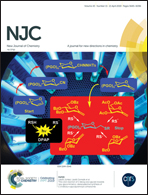Synthesis and properties of a series of iridium complexes with imidazolo[2,1-b]thiazole derivatives as primary ligands†
Abstract
3-Methyl-6-phenylimidazo[2,1-b]thiazole (mpmt) and 3-methyl-6-(4-(trifluoromethyl)phenyl)imidazo[2,1-b]thiazole (mtfpmt) were easily prepared from thiourea, acetone (or trifluoroacetone), and α-bromoacetophenone as novel primary ligands. These were used to synthesize ten phosphorescent iridium complexes with picolinate (pic), isoquinoline-5-carboxylic acid (3-IQA), quinoline-2-carboxylic acid (2-QA), phenyl isoquinoline (piq), and 1,4-difluorophenyl pyrimidine (dfppy) as ancillary ligands. Their structures, photoluminescence, and electrochemistry were investigated. The introduction of trifluoromethyl groups at the phenyl ring of mpmt and to mtfpmt blue shifts the emission spectra of Ir3+ complexes by about 50 nm, and the corresponding emission peaks in CH2Cl2, which shifted from 545 to 613 nm, were observed at room temperature with an increase in the corresponding internal quantum efficiencies (IQEs) from 5.8% to 31.6%. Constructed with title complexes as emitters, LED chips based on InGaN chip excitation show good performances. Particularly, a device based on (mpmt)2Ir(2-QA) showed the best red light emission with a CIE (0.64, 0.30), a CRI of 72.0, and a color purity that was over 80%. Also, a device based on (mpmt)2Ir(3-IQA) provided a maximum luminescence efficiency of 3.01 lm W−1. These results suggest that the title complexes have potential applications in LED chips and OLEDs.
![Graphical abstract: Synthesis and properties of a series of iridium complexes with imidazolo[2,1-b]thiazole derivatives as primary ligands](/en/Image/Get?imageInfo.ImageType=GA&imageInfo.ImageIdentifier.ManuscriptID=C8NJ06295A&imageInfo.ImageIdentifier.Year=2019)


 Please wait while we load your content...
Please wait while we load your content...